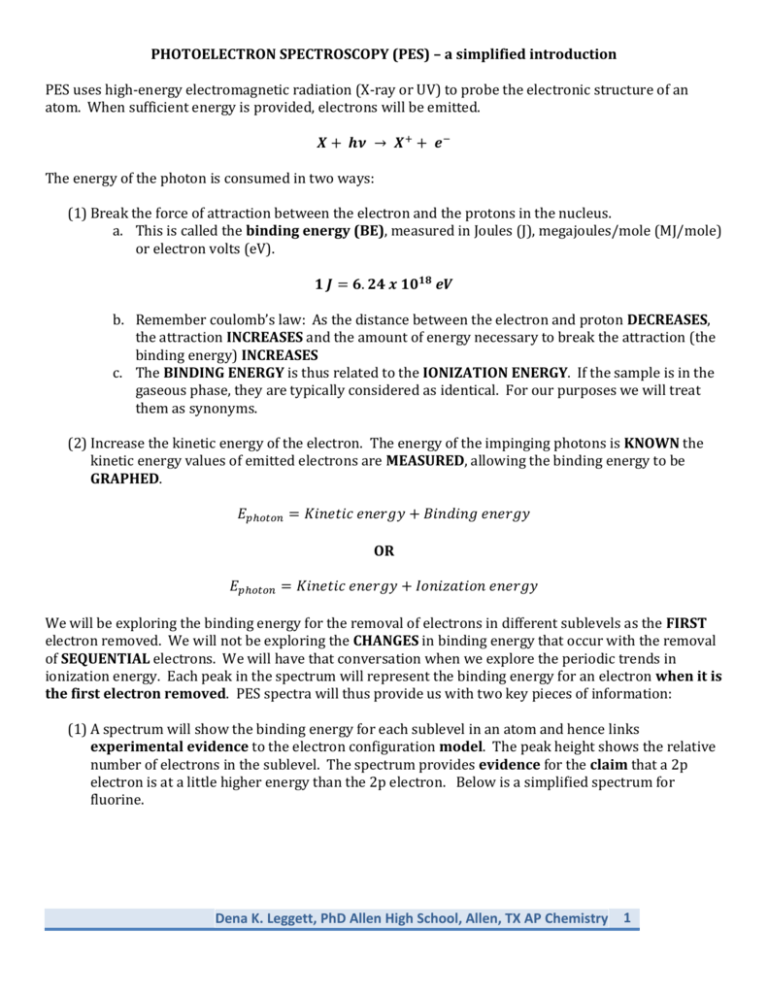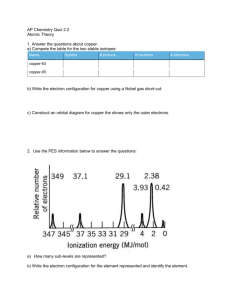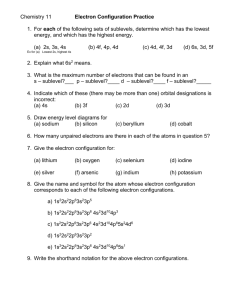Dr. Leggett`s PES handout
advertisement

PHOTOELECTRON SPECTROSCOPY (PES) – a simplified introduction PES uses high-energy electromagnetic radiation (X-ray or UV) to probe the electronic structure of an atom. When sufficient energy is provided, electrons will be emitted. 𝑿 + 𝒉𝝂 → 𝑿+ + 𝒆− The energy of the photon is consumed in two ways: (1) Break the force of attraction between the electron and the protons in the nucleus. a. This is called the binding energy (BE), measured in Joules (J), megajoules/mole (MJ/mole) or electron volts (eV). 𝟏 𝑱 = 𝟔. 𝟐𝟒 𝒙 𝟏𝟎𝟏𝟖 𝒆𝑽 b. Remember coulomb’s law: As the distance between the electron and proton DECREASES, the attraction INCREASES and the amount of energy necessary to break the attraction (the binding energy) INCREASES c. The BINDING ENERGY is thus related to the IONIZATION ENERGY. If the sample is in the gaseous phase, they are typically considered as identical. For our purposes we will treat them as synonyms. (2) Increase the kinetic energy of the electron. The energy of the impinging photons is KNOWN the kinetic energy values of emitted electrons are MEASURED, allowing the binding energy to be GRAPHED. 𝐸𝑝ℎ𝑜𝑡𝑜𝑛 = 𝐾𝑖𝑛𝑒𝑡𝑖𝑐 𝑒𝑛𝑒𝑟𝑔𝑦 + 𝐵𝑖𝑛𝑑𝑖𝑛𝑔 𝑒𝑛𝑒𝑟𝑔𝑦 OR 𝐸𝑝ℎ𝑜𝑡𝑜𝑛 = 𝐾𝑖𝑛𝑒𝑡𝑖𝑐 𝑒𝑛𝑒𝑟𝑔𝑦 + 𝐼𝑜𝑛𝑖𝑧𝑎𝑡𝑖𝑜𝑛 𝑒𝑛𝑒𝑟𝑔𝑦 We will be exploring the binding energy for the removal of electrons in different sublevels as the FIRST electron removed. We will not be exploring the CHANGES in binding energy that occur with the removal of SEQUENTIAL electrons. We will have that conversation when we explore the periodic trends in ionization energy. Each peak in the spectrum will represent the binding energy for an electron when it is the first electron removed. PES spectra will thus provide us with two key pieces of information: (1) A spectrum will show the binding energy for each sublevel in an atom and hence links experimental evidence to the electron configuration model. The peak height shows the relative number of electrons in the sublevel. The spectrum provides evidence for the claim that a 2p electron is at a little higher energy than the 2p electron. Below is a simplified spectrum for fluorine. Dena K. Leggett, PhD Allen High School, Allen, TX AP Chemistry 1 Note (1) the ratio of peak height is 5:2 representing the electron ratio of 5:2 (2) the IE for the “p” electrons is less than the “s” electrons Note that the IE of the 1s electron is higher than the 2s & 2p. It is closer to the nucleus so experiences greater attraction. 2p5 2s2 1s2 CAUTION: evaluate the x-axis carefully. Sometimes energy is graphed low to high and others high to low. (sorry – hate it for you!) (2) Comparison of spectra beautifully demonstrates how the actual energy of energy levels varies as the nuclear charge, Z, increases. This in turn illustrates why each element has a unique atomic spectrum! 𝑭𝟐𝒑𝟓 Note that the IE for a Fluorine 1s electron is greater than for nitrogen. This is due to the differences in nuclear charge, Z. REMEMBER COULOMB’S LAW! ZF = 9 and ZN = 7 𝑵𝟐𝒑𝟑 𝑵𝟐𝒔𝟐 𝑭𝟐𝒔𝟐 𝑵𝟏𝒔𝟐 𝑭𝟏𝒔𝟐 INQUIRY ACTIVITY: 1. A PES spectrum is shown above. a. Identify the element and write its electron configuration. b. Sketch the expected spectrum of phosphorus on the graph, making sure to show the relative changes in positions (not the exact energy) of the peaks and the relative intensity of each peak. 2. How many peaks would you anticipate for copper (ignoring any splitting within a sublevel)? The relative intensity of peaks for fluorine is 2:2:5. What is the relative intensity of peaks for copper? 3. A student makes the following claim regarding the PES spectra of Mg2+ and Ne. Is the statement true or false? Justify your answer. Since Mg2+ is isoelectronic with Ne, the PES spectra will be identical. 4. A sample of an unknown element was studies using photons with energy of 198.2 MJ/mole. The kinetic energy of the ejected electrons was determined to be 38.6 MJ/mole. What is the binding energy for these electrons? Dena K. Leggett, PhD Allen High School, Allen, TX AP Chemistry 3 5. A portion of the PES spectra for phosphorus and sulfur depicting the 3p and 3s electrons is shown above. Although the nuclear charge for sulfur is GREATER than phosphorus, the binding energy for the 3p electrons is unexpectedly LOWER for sulfur. Justify this observation in terms of repulsive and attractive forces. REFERENCES: http://www.pes.arizona.edu/aboutPES.htm http://www.chem.arizona.edu/chemt/Flash/photoelectron.html http://www.chem.qmul.ac.uk/surfaces/scc/scat5_3.htm http://scidiv.bellevuecollege.edu/jm/c140/c140%20f06/POGIL/PES_140.pdf https://sites.google.com/site/brinnbelyeascience/home/story-centered-ap-chemistrycurriculum/units-of-study-scc-chemistry/unit-3-atomic-structure/photoelectronspectroscopy http://www.google.com/url?sa=t&rct=j&q=&esrc=s&source=web&cd=2&ved=0CD8QFjAB &url=http%3A%2F%2Fwww.shodor.org%2Fteacherforum%2Fmedia%2Fdoc%2FPhotoel ectron%2520Spectroscopy%2520Inquiry%2520F.doc&ei=5wjkUYSaPIHzygG18IGgCw&us g=AFQjCNF3PWr2zz7uZov_9uB_bc_KncpJ6A&bvm=bv.48705608,d.aWc







